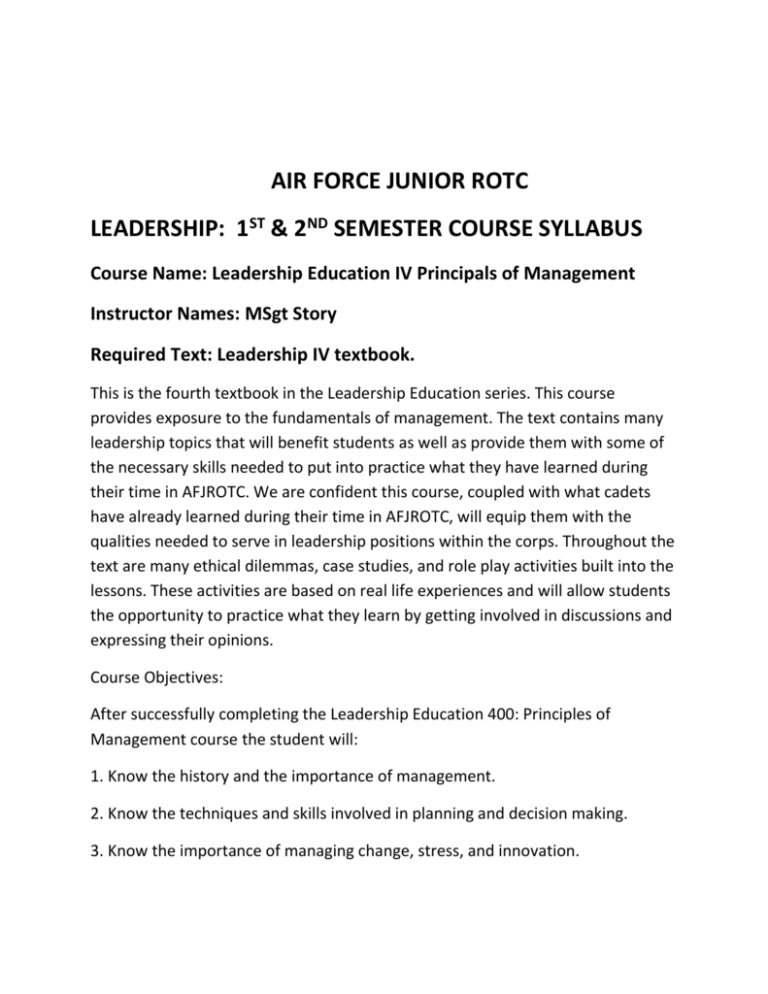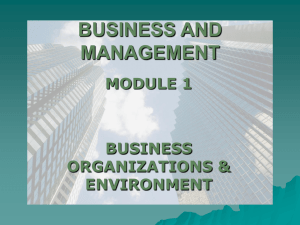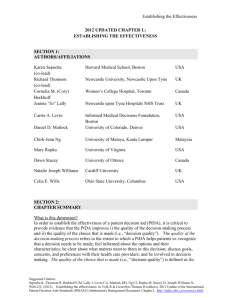2. Chapter In Brief - Scott County Schools
advertisement

AIR FORCE JUNIOR ROTC LEADERSHIP: 1ST & 2ND SEMESTER COURSE SYLLABUS Course Name: Leadership Education IV Principals of Management Instructor Names: MSgt Story Required Text: Leadership IV textbook. This is the fourth textbook in the Leadership Education series. This course provides exposure to the fundamentals of management. The text contains many leadership topics that will benefit students as well as provide them with some of the necessary skills needed to put into practice what they have learned during their time in AFJROTC. We are confident this course, coupled with what cadets have already learned during their time in AFJROTC, will equip them with the qualities needed to serve in leadership positions within the corps. Throughout the text are many ethical dilemmas, case studies, and role play activities built into the lessons. These activities are based on real life experiences and will allow students the opportunity to practice what they learn by getting involved in discussions and expressing their opinions. Course Objectives: After successfully completing the Leadership Education 400: Principles of Management course the student will: 1. Know the history and the importance of management. 2. Know the techniques and skills involved in planning and decision making. 3. Know the importance of managing change, stress, and innovation. 4. Know the key elements of individual and group behavior, the importance of the communication process, and the characteristics of a good leader. 155 Unit One Introduction to Management Chapter 1: Managers and Management 1. Chapter Objectives a. Know who managers are. b. Know where managers work. c. Know what management is. d. Know what managers do. 2. Chapter In Brief Chapter 1 consists of two lessons. Lesson 1 “Management Basics” begins by addressing who managers are, where they work, what management is, and what managers do. Management is defined as well as the titles of top managers. Management processes are covered and defined. Students will learn why people perform better when managers work well with team members. Students will also learn about making decisions and dealing with change. Lesson 2 “Management in the Marketplace” covers such topics as the skills and competencies successful managers possess; the importance the marketplace puts on managers; why management is worth studying, and how management relates to other disciplines. Emphasis is placed on specific skills and competencies managers need to possess in order to be effective. There is discussion on the results good managers produce and the pay associated with management positions which will convey to students why management is worth studying. Lastly, students will learn how management skills relate to other disciplines of study such as political science, psychology, anthropology, economics, philosophy, and sociology, etc. 156 Chapter 2: The Historical Roots of Contemporary Management Practice 1. Chapter Objectives a. Know the history of management before the modern era. b. Know the classical contributions to modern management. c. Know the human resources approach to management. d. Know the quantitative approach to management. e. Know how social events shape management approaches. f. Know management approaches today. 2. Chapter In Brief Chapter 2 contains two lessons. Lesson 1 is titled “Management Theories”. The ways that historical theories currently influence what managers do today is discussed. Students will see the important links between past theories, present actions, and future innovations. They will learn that today’s innovations have many of their roots in the past. There is information on the contributions that Adam Smith, Henri Fayol, Frederick Taylor, and Max Weber made to the field of management. Students will learn about the influence the industrial revolution had on management practice as well as classical contributions to modern management and how classical writings are applied today. Lesson 2 is titled “Management Approaches” and places emphasis on the various approaches to management used today to include the process approach, systems approach, and the contingency approach, and the different points of view that people have toward management. Students will learn that some approaches are more oriented to treating people well and others are more oriented to structured practices and processes. Emphasis is placed on the importance of considering both the satisfaction of workers and the efficiency and effectiveness of work. There are discussions on the contributions and views of Hugo Munsterberg, Mary Parker Follett, Chester Barnard, Dale Carnegie, Abraham Maslow, Douglas McGregor, and Robert McNamara, etc. Chapter 3: The Management Environment 1. Chapter Objectives a. Know about management and the changing economy. b. Know about the global marketplace. c. Know about management and technology. d. Know what society expects from organizations and managers. e. Know how entrepreneurship impacts society. f. Know about the workforce and labor. 2. Chapter In Brief Lesson 1 “Management and the Economy” makes students aware of management and the changing economy, the global marketplace, and management and technology. Students will learn that the effects of globalization and technology are absolutely critical. The lesson discusses Alvin Toffler’s argument that modern civilization has come in three waves: agriculture, industrial, and information. The global marketplace is discussed with emphasis on the globalization of business and how globalization affects organizations and managers. Management and technology are discussed as well as how an organization benefits from information technology and how technology alters a manager’s job. In Lesson 2, “Management and Society”, students will learn about the way in which society impacts the work of managers. They will also learn that the social issues managers face are complicated due to the influence of a variety of social factors. They will also learn what society expects from organizations and managers, how organizations demonstrate socially responsible actions, and how managers become more socially responsible. Three views of ethics are discussed: the utilitarian view, the rights view and the theory-of-justice view. There is discussion on entrepreneurship, the entrepreneurial process, what entrepreneurs do, and entrepreneurs within large organizations. Students will learn about the workforce and labor and what today’s workforce looks like. Students will learn how diversity affects organizations and how organizations help employees with work/life balance. Finally, there is information on a pending labor shortage in the United States and two factors that contribute to that labor shortage. 158 Unit Two Planning Chapter 4: Foundations of Planning 1. Chapter Objectives a. Know what planning is. b. Know about planning in uncertain environments. c. Know types of plans. d. Know about management by objectives. e. Know approaches to establishing goals. f. Know about developing plans. g. Know about contemporary issues in planning. 2. Chapter In Brief Lesson 1 “Planning Basics” defines planning. Students will learn about planning and what it involves. They will read about the arguments for and against formal planning and about the different kinds of plans – strategic versus tactical; directional versus specific; short term versus long-term; and single-use versus standing plans. Students will study about management by objectives and why many businesses today involve their employees in setting performance objectives to meet organizational goals. They will learn how to set employee objectives and how a manager helps employees set work goals. Students will also learn how an influential thinker in the quality-management field thinks goalsetting may do more harm than good. Lesson 2, “Establishing Goals and Developing Plans”, places emphasis on the different approaches to establishing goals, characteristics of well-thought-out goals, and steps in goal setting. Students will learn the three contingency factors managers must consider as they plan. The last topic covered is “contemporary issues in planning” and includes criticisms of planning. Students are given steps they can take now toward becoming a manager. 158 Unit Two Planning Chapter 4: Foundations of Planning 1. Chapter Objectives a. Know what planning is. b. Know about planning in uncertain environments. c. Know types of plans. d. Know about management by objectives. e. Know approaches to establishing goals. f. Know about developing plans. g. Know about contemporary issues in planning. 2. Chapter In Brief Lesson 1 “Planning Basics” defines planning. Students will learn about planning and what it involves. They will read about the arguments for and against formal planning and about the different kinds of plans – strategic versus tactical; directional versus specific; short term versus long-term; and single-use versus standing plans. Students will study about management by objectives and why many businesses today involve their employees in setting performance objectives to meet organizational goals. They will learn how to set employee objectives and how a manager helps employees set work goals. Students will also learn how an influential thinker in the quality-management field thinks goalsetting may do more harm than good. Lesson 2, “Establishing Goals and Developing Plans”, places emphasis on the different approaches to establishing goals, characteristics of well-thought-out goals, and steps in goal setting. Students will learn the three contingency factors managers must consider as they plan. The last topic covered is “contemporary issues in planning” and includes criticisms of planning. Students are given steps they can take now toward becoming a manager. Chapter 5: Foundations of Decision Making 1. Chapter Objectives a. Know what defines a decision problem. b. Know the rational model for decision making. c. Know about modification of the rational model. d. Know the contingency approach to decision making. e. Know decision-making styles. f. Know about making decisions in groups. g. Know about culture and decision making. 2. Chapter In Brief In Lesson 1“The Decision-Making Process” students will learn that the decision-making process is a set of eight steps. They will learn that decision making is a critical skill for life. They will learn the definition of a decision problem and the eight steps used to define a decision problem. Focus is given on what is relevant in the decision-making process and how the decision maker weighs the criteria. The lesson further places emphasis on the rational model for decision making, why creativity is important in decision making and common errors in the decision-making process. Lesson 2 is titled “Decision-Making Challenges” and stresses the different types of problems we have to solve and the different ways we approach decision making when we are working to solve those problems. There is discussion on how problems differ and the different levels in the organization. Students will learn how technology aids in decision making. They will also learn the four basic decision-making styles. Lastly, the students will learn about culture and decision making. MAKEUP ASSIGNMENTS: There are makeup assignments for excused absences. Cadets will receive a grade of zero for unexcused absences. GRADING SCALE USED IN THE SCOTT COUNTY SCHOOL DISTRICT: GRADE PERCENT A 93 – 100 B 83 – 92 C 76 – 82 D 68 – 75 F 67 and below









